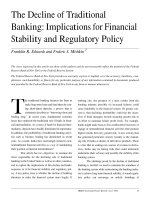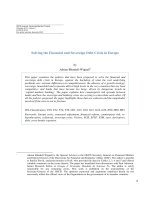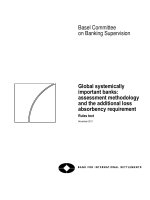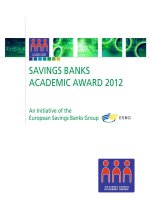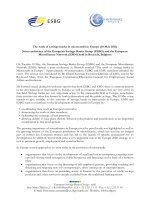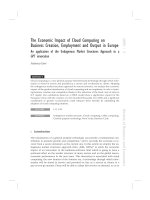The work of savings banks in microcredit in Europe (10 May 2011) Joint conference of the European Savings Banks Group (ESBG) and the European Microfinance Network (EMN) held in Brussels, Belgium pot
Bạn đang xem bản rút gọn của tài liệu. Xem và tải ngay bản đầy đủ của tài liệu tại đây (143.3 KB, 7 trang )
European Savings Banks Group - aisbl
Rue Marie-Thérèse, 11
■ B-1000 Bruxelles ■ Tel: + 32 2 211 11 11 ■ Fax: + 32 2 211 11 99
E-mail: first ■ Website: www.esbg.eu
The work of savings banks in microcredit in Europe (10 May 2011)
Joint conference of the European Savings Banks Group (ESBG) and the European
Microfinance Network (EMN) held in Brussels, Belgium
On Tuesday 10 May, the European Savings Banks Group (ESBG) and the European Microfinance
Network (EMN) hosted a joint conference in Brussels entitled “The work of savings banks in
Microcredit in Europe”. Approximately 40 policymakers, ESBG and EMN members attended the
event. The session was introduced by Mr Daniel Sorrosal, Executive Director of EMN, and by Mr
Raymond Maes, from the European Commission Directorate-General for Employment, Social
Affairs and Inclusion.
Mr Sorrosal stated during his welcome speech that both ESBG and EMN share a common interest
in the development of microcredit in Europe, as well as common members that are very active in
this field. Savings banks are very important actors in the microcredit field in Europe, nonetheless
their activities are often less known by both policymakers and the public at large. The 10 May event
intends to give visibility to the activities of savings banks in microcredit in Europe. EMN and
ESBG want to contribute to the development of microcredit in Europe by:
• coordinating their work as European networks;
• showcasing the work of their members;
• facilitating the exchange of best practices;
• allowing debate to take place directly between policymakers and practitioners as an important
contribution to this development.
The growing importance of microfinance in Europe over the past decade was highlighted as well as
the growing interest of the European institutions in microfinance, which has become an integral
part of current key European policies and has led to the launch of specific instruments for its
development. In addition, microcredit plays a very important role in the Europe 2020 strategy, as a
tool to promote growth, employment and social inclusion.
In Europe several approaches co-exist today in the provision of microcredit:
• organisations that focus on the development of small and micro-enterprises, targeting start-
ups and existing small enterprises, viable businesses and financing on the basis of a business
plan;
• organisations that focus on the financing of self-employed persons, providing coaching and
financing and targeting new solo entrepreneurs, often coming out of unemployment;
• organisations that focus on extending access to finance by the provision of credit, savings
products and other services to people excluded from the traditional banking sector.
2
The growth in scale of microcredit in Europe was considered only to be possible with the
involvement of key financial actors, in particular savings banks. Their approach may differ in terms
of target public, methodology and communication, but the objectives are common to all of them:
fostering entrepreneurship, local development, employment and financial inclusion in Europe.
Mr Maes, as keynote speaker from the European Commission, provided an overview of the Europe
2020 strategy, which responds to the challenges that Europe is facing in the next decade. Within
Europe 2020, microcredit is adopted as a tool to address social exclusion. Micro-entrepreneurship is
a relevant source of employment in the EU, given that each new micro-enterprise creates two to
three new jobs. Entrepreneurship is another path to promote employment. Currently, only 5% of
adults in Europe have created their own company, which highlights the need for a shift towards a
more entrepreneurial culture.
The European Commission is responding to these challenges through a number of initiatives to
promote micro-enterprise, such as the JEREMIE and the JASMINE programmes. Savings banks
have a particular role to play in the development of microfinance, since they finance the local
economy in the communities where they operate. They are thus intrinsically linked to the social
objectives of the 2020 strategy. In addition, the European Commission is currently developing a
code of good conduct to provide standards to European MFIs in the provision of microcredit.
The Commission sees the role of the savings banks as a complementary to non-banking financial
institutions, since they often target different segments of the microcredit clientele. Mr Maes
concluded by stating that the European Commission is willing to support further involvement of
savings banks in the microfinance sector in Europe.
Workshop: Microcredit as a tool to promote entrepreneurship and local development in
Europe
The workshop was introduced by Mr Philippe Delvaux from the Directorate General for Regional
Policy, with the participation of Jennifer Rowe from good.bee Holding (Austria) and Bertram
Reddig from DSGV (Germany).
European Union – Regional policy –
Mr Delvaux, as Principal Administrator of the Financial Engineering Unit of DG Regio, presented
the role that structural funds play in the development of European regions, and highlighted that the
European Regional Development Fund (ERDF) currently supports small businesses with a budget
allocation of €27 million.
The development of microfinance in Europe requires a mix of both funding and technical
assistance in order to adequately serve the market. In Europe, there are two types of micro-
borrowers: those who want to start their business but do not have collateral; and those who already
have a business but face difficulties in obtaining funding from the traditional banking sector. The
low amounts required and high costs of serving such clients render them unattractive to the
traditional banking sector.
Some of the challenges in the sector are developing a common definition of the terms used in the
microfinance sector and involving all the actors in the development of this sector in Europe. The
financial crisis has had a “positive” impact on microfinance institutions, in that they have diversified
their funding sources and taken steps to reduce dependence on subsidies. In addition, there has
3
been a shift within the European Commission, moving away from grant provision and introducing
financial engineering instruments.
In 2007, the European Commission published the Communication “A European Initiative for the
development of microcredit in support of growth and development”, with four main objectives:
1. Improving the legal and institutional environment.
2. Changing the climate in favour of entrepreneurship.
3. Providing capacity building to European MFIs.
4. Providing additional financial capital for micro-credit institutions.
In his conclusions, Mr Delvaux stressed that microcredit has the potential to develop
entrepreneurship. European governments in Europe need to develop the right environment to
foster this sector. Both the banking and non-banking sectors have a role to play. It is a complex
issue involving many actors but can be a win-win undertaking for all.
After Mr Delvaux’s presentation, the audience raised two questions:
Q – How do you see the role of savings banks in microfinance?
Savings banks have experience in disbursing loans, not necessarily big loans, and in social
responsibility; they can act as partners with a long-term view; they can be investors, working in
partnership with non-banks, and share best practices with the non-banking sector.
Q – Would you see savings banks as disbursement institutions for the JEREMIE funds?
Savings banks would need to comply with the criteria since managing structural funds is a bit
different, but it is possible. The European Commission certainly welcomes volunteers.
Good.bee holding (Austria) –
Ms Rowe introduced good.bee Holding, a joint venture of the Erste Group and Erste Foundation
and one of the main financial investors in Central and Eastern Europe. Their vision is that all
individuals and firms in Central and Eastern Europe have access to responsible banking services
and products that are simple and transparent. Good.bee’s mission is to develop innovative solutions
to break down the barriers to financial inclusion. Good.bee is guided by three principles:
1. The good of the customer is at the heart of our business.
2. They and their customers do business on a commercially viable basis.
3. They do business with like-minded partners with whom they share common goals.
The main activities are microfinance and social enterprise. There is a real need, as 35 million adults
in Central and Eastern have no access to banks. Ms Rowe presented good.bee’s initiatives in three
countries: Austria, Hungary and Romania.
• In Austria, Erste Group launched a programme in May 2010 together with the Ministry for
Social Affairs, called “Der Mikrokredit”, targeting unemployed people or those at risk of
losing their jobs.
• In Hungary, Erste Group launched a programme called “There is a chance!” in March 2011
to tackle energy poverty: it is a home improvement loan offered exclusively to low-income
4
families. This example shows that micro-lending can also target welfare needs, not only
income generating activities.
• In Romania in 2009, good.bee launched an initiative called “Tranzactii mobile”, which
enables customers to access their bank account through mobile phones.
Generally, people benefitting from good.bee loans are farmers and employees who have lost their
job, allowing them to start income generating activities. The “Der Mikrokredit” initiative targets
those who lost or are at risk of losing their jobs, enabling them to start their own businesses.
Ms Rowe reckons that in many instances they can improve the quality of people’s lives, but not
raise them out of poverty. In her conclusions, Ms Rowe stressed that micro-lending is a good tool
but must not be favoured to the detriment of SME lending, because SMEs are the backbone of the
economy in Europe.
After the end of her presentation, the audience raised two questions:
Q – Could you please clarify good.bee’s view on the role of social enterprise finance and the link
with microfinance?
Microfinance is the provision of small-scale financial services to those who previously lacked access
to finance, whereas social entrepreneurship is the creative resolution of pressing social needs.
Within good.bee we asked banks where we invest to earmark funds for the financing of pressing
social needs, since social enterprises have the same needs as “traditional” businesses.
Q – Do you have any public support?
Regarding Erste Group, “Der Mikrokredit” initiative launched together with the Ministry of Social
Affairs has support from a group of six Austrian foundations, the goal being to finance it on a
commercial basis and not to rely on subsidies.
Deutscher Sparkassen-und Giroverband (Germany) –
Mr Reddig gave an overview of the system of savings banks in Germany and explained that three
out of four enterprises are clients of the savings banks group (the “Sparkassen”). As savings banks
are deeply rooted in the local business area, they deal with smaller financial projects (i.e. micro-
entrepreneurs). Microcredit is part of the pool of normal credits, and therefore Sparkassen don’t
collect data on the number of micro-loans granted. Some clients need extra support for qualitative
improvement of their projects; Sparkassen are encouraged to cooperate with local partners for
client support, including microcredit institutions where available. There is no public support for
Sparkassen, but they cooperate with institutions that can obtain public support (e.g., business
development services).
According to a one-time survey in 2009, it was estimated that there were some 420,000 microloans
disbursed for business purposes only. The average amount of the loan was €5,100.
Workshop – Promoting social inclusion and employment through microcredit in Europe
The second workshop was introduced by Mr Raymond Maes from the Directorate General
Employment, Social Affairs and Inclusion, with the participation of Fernando Vega from Cajasol
(Banca Cívica Savings Banks, Spain), and Perrine Lantoine-Rejas from Féderation Nationale de
Caisses d’Epargne (BPCE, France).
5
Mr Maes gave a short overview of the Commission initiatives to promote social inclusion and
employment, encouraging access to credit to vulnerable groups. Microfinance is one of the key
tools to support these initiatives. The latter are addressed to young people (with no credit history),
minority groups and people with disabilities.
The European Investment Fund (EIF) manages the funds allocated to microfinance. By way of
example, the European Progress Microfinance Facility is a microfinance initiative established in
March 2010 with €200 million of funding from the European Commission and the European
Investment Bank. Progress Microfinance aims to increase access to finance for individuals who
have lost or are at risk of losing their job or have difficulties entering or re-entering the labour
market. In addition to individuals, Progress Microfinance will also support micro-enterprises,
including those in the social economy, providing jobs for the unemployed or the disadvantaged.
The EIF has guaranteed and funded instruments within this initiative: guarantees were set up in July
2010.
There are already several operators in Europe benefiting from Progress Microfinance: Qredits in the
Netherlands, MicroStart in Belgium, FN Bank in Poland and recently Microfund in Bulgaria. EIF
has received several applications from EU countries and around 14 operations should be in place by
the end of 2011. One of the conditions is that applicants have to collect socio-economic data of the
borrowers. Mr Maes wants to develop ways to publish best practices to all the beneficiaries,
especially those targeting the most vulnerable people, and stressed the Commission’s willingness to
develop microfinance capacity in Europe.
Cajasol (Spain) –
Mr Vega explained that within Cajasol (Banca Cívica) microfinance is seen as a supporting tool for
social inclusion processes. Cajasol works together with organisations dealing with social issues that
are not traditionally addressed by banks. The real challenge faced by Cajasol’s programme is to find
mechanisms to achieve sustainability.
Cajasol’s programme targets the poorest of the poor, based on the Grameen bank methodology. A
group of volunteers (among Cajasol employees) works with groups of people that have not access
to employment and mostly depend of social welfare. The first step is to increase their confidence
through a series of activities (regular meetings, conferences, workshops); once they reach a certain
level of confidence, they can access loans.
At the end of the presentation, Mr Vega gave further details concerning the volunteer model,
namely on how some employees allocate extra time to this specific project. Concerning the follow-
up, beneficiaries can be looked after for up to five years until they leave social exclusion. The
average period to obtain a loan (without any collateral) can take up to 1.5 months, including a visit
to potential borrowers. According to Mr Vega, a 6.5% interest rate would be necessary to make this
model completely sustainable, as long as volunteers don’t receive any salary. These volunteers need
to receive special training, given that this activity differs from their normal activities. Cajasol works
with a team of three employees and 15 volunteers.
Good.bee explained that in Romania the interest rate amounts to 20%. Another example of
volunteering was presented, by which 430 volunteers collaborate with three employees in a specific
Austrian savings bank. The majority of the volunteers are retired people from the bank, who are
willing to serve society.
6
FNCE (Fédération Nationale des Caisses d’Epargne) (France)
Ms Lantoine-Rejas explained that there are 17 savings banks in France with more than 4,000
branches that serve 27 million customers. French savings banks area committed to three main
aspects as far as microfinance is concerned:
• microcredit and related products and services;
• financial literacy (face-to-face training with approximately 55,000 beneficiaries);
• international cooperation (missions in Africa).
Personal microcredit is a small loan to people who cannot secure one from the banking system and
who will be helped to gain or regain control of their personal finances. FNCE’s approach is to
respond to specific needs with long-term solutions that promote financial inclusion. In this respect,
Ms Lantoine-Rejas gave an overview on “Parcours Confiance”, a non-profit institution created by
the French savings banks, dedicated to the provision of microcredit, combined with the provision
of financial literacy programmes and financial and social monitoring. An impact study recently
carried out on this initiative has revealed high levels of satisfaction amongst beneficiaries, with 76%
of clients having improved their personal situation on at least one aspect (financial situation,
housing, professional situation…).
According to Ms Lantoine-Rejas, personal microcredit has a proven social utility. In this respect, a
customised financial and social follow-up is key to success. In addition, personal microcredit can be
the first step to starting a business, having an indirect effect on employment. Public support to
boost these initiatives has been decisive, for example, via guarantee funds.
Three questions were asked by the panel:
Q – What are the motivations of the savings banks to undertake microfinance? Is it philanthropy or
a way of doing business?
Microfinance today is not sustainable completely, thus there is a need to adapt the model in order to
make it sustainable; it’s a social approach and a business approach; it’s an experiment for the time
being.
Q – Do you have results?
We look at it from a long-term perspective. Gaining clients is one of the aims. The return on
investment will come after some years.
Q – Have you done any analysis on the default rate? Between business and personal microcredit?
Not a real difference. We are more affected in business microcredit because the amount lent is
higher.
Closing speech
Mr Chris De Noose, ESBG Managing Director, delivered the closing speech, stating that
microfinance is a savings bank tradition and an important means to stimulate social inclusion and
job creation. Savings banks tailor their products in order to finance micro and small enterprises and
7
create specific programmes that support excluded individuals, helping them to create their own
enterprises and thus jobs in Europe.
Mr De Noose explained that it is important that savings banks continue to be involved in future
EU microfinance programmes, taking part in the design of new capacity building instruments that
may complement financial instruments. Microcredit, as a form of inclusive finance, requires
appropriate instruments that enhance financial literacy of individuals. It would be thus desirable to
develop financial inclusion instruments that support financial literacy in the field of microcredit for
individuals, focusing on banking products and the individual’s relationship with the bank. It was
also pointed out that the link between business support services and microcredit providers could be
strengthened. By way of example, this could be done through the development of new capacity
building instruments that improve business support services for microenterprises, and that provide
microfinance-specific training for both savings banks and business support entity employees.
Another key aspect highlighted was the need to promote quality standards for microfinance and
start-up support services at the national level. Furthermore, the scope of European instruments
related to microcredit could be widened to other financial services, such as micro-savings, micro-
leasing or micro-insurance. The role of Member States as facilitator of a micro-entrepreneur friendly
legal environment was also highlighted. There is a need to increase cooperation between savings
banks and non-bank microcredit providers, and in this respect, ESBG welcomes the Commission’s
efforts to develop a Code of Good Conduct for microcredit provision in the EU.
Mr De Noose expressed his support, both on behalf of ESBG and EMN, to future European
initiatives in the field of microcredit, as well as of the commitment and willingness of savings banks
to increase their participation in the field of microfinance.
